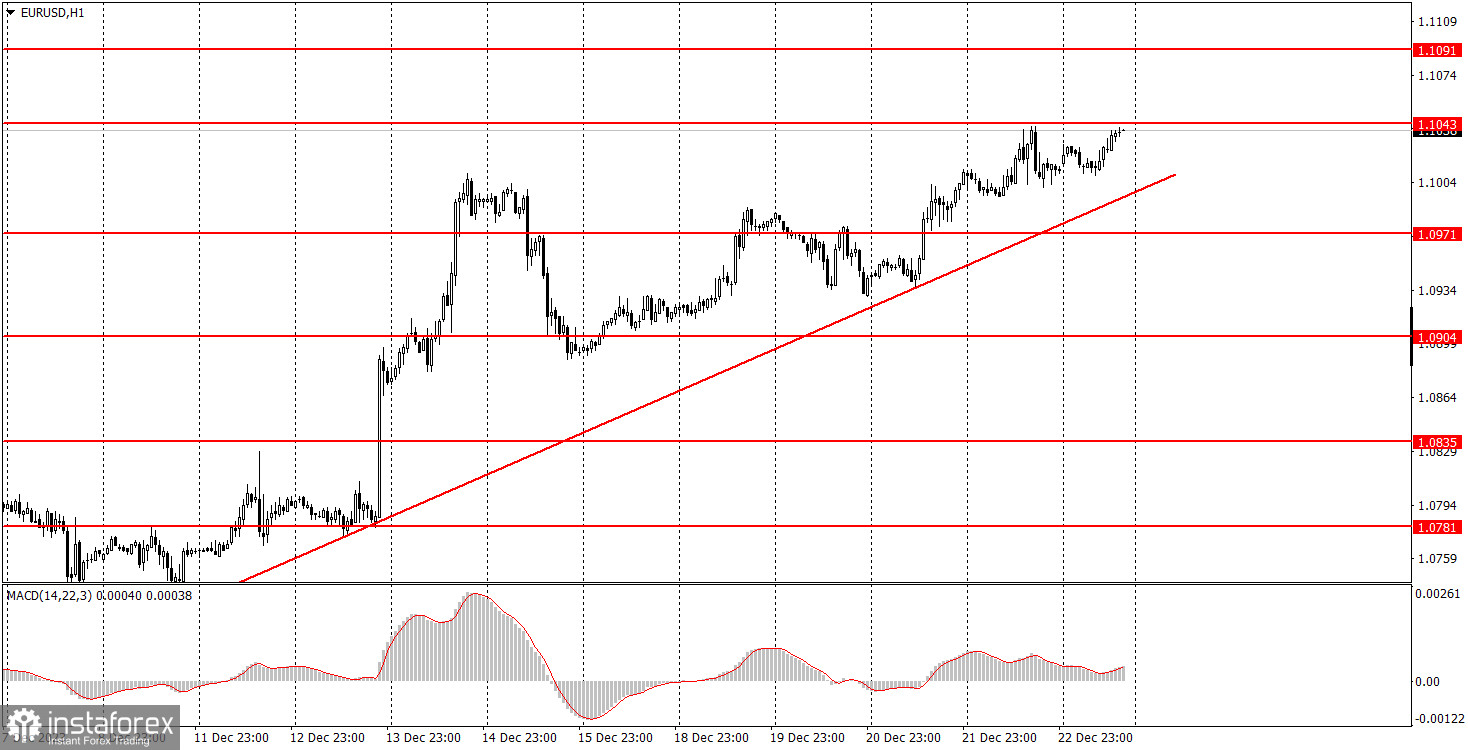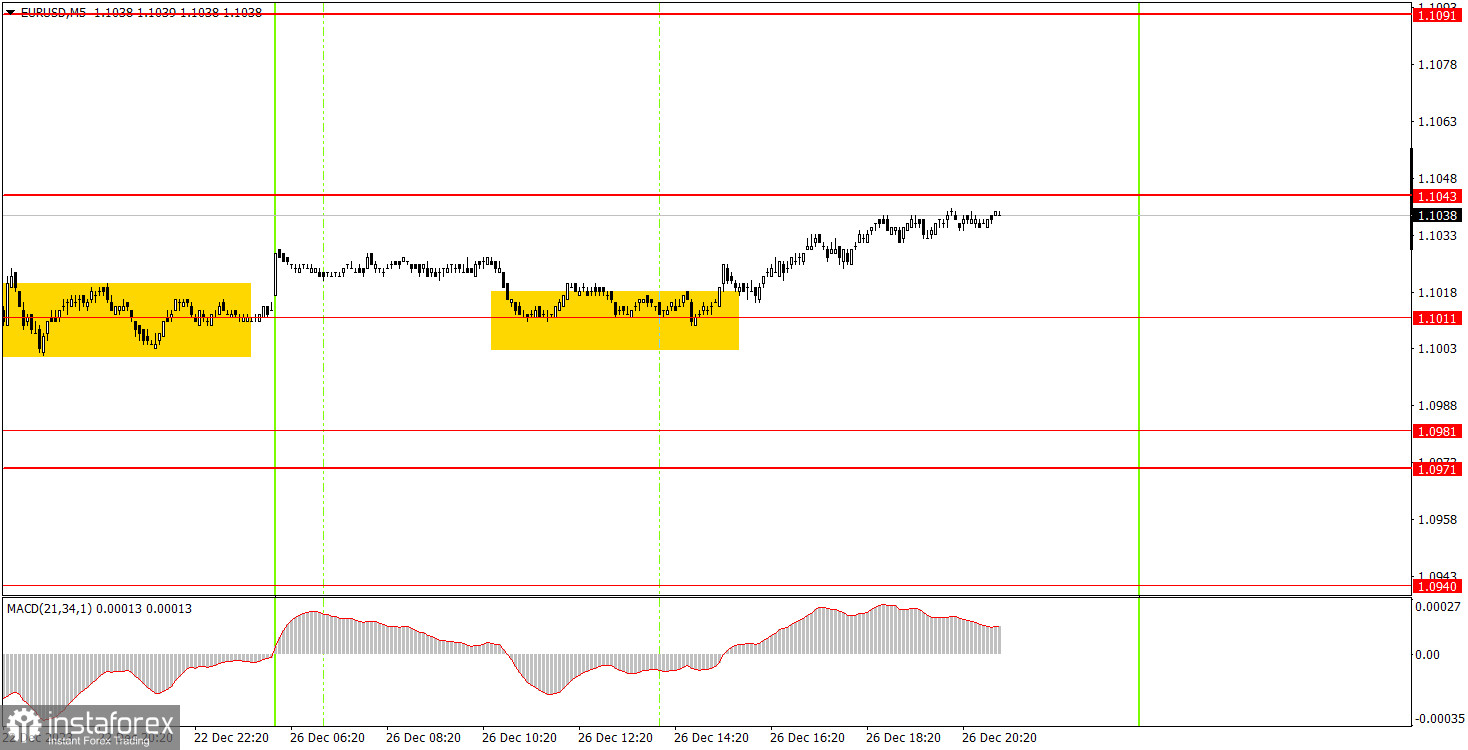Analyzing Tuesday's trades:
EUR/USD on 30M chart

EUR/USD showed volatility of 30 pips on Tuesday. This is not surprising, as the holiday week has started, and there are no scheduled events in the US, Germany, or the European Union. Not even secondary events! However, this isn't the only issue here. In the run-up to the holidays and during them, many market participants withdraw, and if traders are not active, the pair does not move. This explains why the pair was passive on Tuesday.
Overall, the uptrend remains intact, as shown by the ascending trendline. However, is it worth trading the pair if it is practically standing still? Beginners should consider this question and find a meaningful answer for themselves. Wednesday's movements will likely be similar to Tuesday's.
EUR/USD on 5M chart

On the 5-minute chart, one buy signal was generated. During the European and US sessions, the price moved along the level of 1.1011 for a long time and eventually bounced off it. Therefore, even beginners could open long positions, which turned out to be profitable as the price reached the level of 1.1043 by the end of the day. Thus, one could earn about 15 pips on a single trade.
Trading tips on Wednesday:
On the hourly chart, EUR/USD maintains an uptrend, which is now supported by the ascending trendline. However, the holiday week has started, and movements can be quite weak. We believe that the euro does not have enough reasons to rise further, but the market holds a different opinion even during the holidays.
On Wednesday and throughout the week, we believe that you should be careful. We might witness bounces or breakthroughs from important levels, making it possible to open trades, but you shouldn't expect strong movements right now. Thus, the potential profit level may be even less than the potential loss.
The key levels on the 5M chart are 1.0611-1.0618, 1.0668, 1.0733, 1.0767-1.0781, 1.0835, 1.0896-1.0904, 1.0940, 1.0971-1.0981, 1.1011, 1.1043, 1.1091, 1.1132-1.1145. On Wednesday, there are no events scheduled in the EU or the US, not even secondary ones. There will be nothing to react to during the day.
Basic trading rules:
1) Signal strength is determined by the time taken for its formation (either a bounce or level breach). A shorter formation time indicates a stronger signal.
2) If two or more trades around a certain level are initiated based on false signals, subsequent signals from that level should be disregarded.
3) In a flat market, any currency pair can produce multiple false signals or none at all. In any case, the flat trend is not the best condition for trading.
4) Trading activities are confined between the onset of the European session and mid-way through the U.S. session, post which all open trades should be manually closed.
5) On the 30-minute timeframe, trades based on MACD signals are only advisable amidst substantial volatility and an established trend, confirmed either by a trend line or trend channel.
6) If two levels lie closely together (ranging from 5 to 15 pips apart), they should be considered as a support or resistance zone.
How to read charts:
Support and Resistance price levels can serve as targets when buying or selling. You can place Take Profit levels near them.
Red lines represent channels or trend lines, depicting the current market trend and indicating the preferable trading direction.
The MACD(14,22,3) indicator, encompassing both the histogram and signal line, acts as an auxiliary tool and can also be used as a signal source.
Significant speeches and reports (always noted in the news calendar) can profoundly influence the price dynamics. Hence, trading during their release calls for heightened caution. It may be reasonable to exit the market to prevent abrupt price reversals against the prevailing trend.
Beginning traders should always remember that not every trade will yield profit. Establishing a clear strategy coupled with sound money management is the cornerstone of sustained trading success.





















